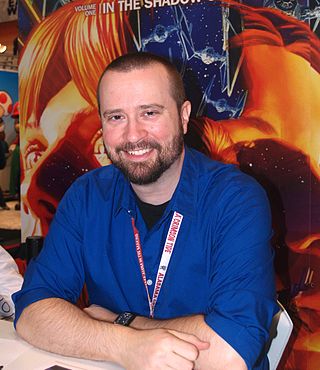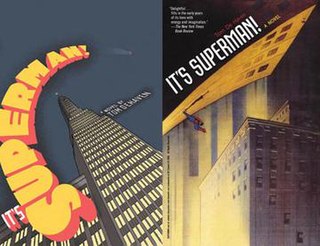Related Research Articles

A comic book, also called comicbook, comic magazine or simply comic, is a publication that consists of comics art in the form of sequential juxtaposed panels that represent individual scenes. Panels are often accompanied by descriptive prose and written narrative, usually, dialogue contained in word balloons emblematic of the comics art form.

An American comic book is a thin periodical originating in the United States, on average 32 pages, containing comics. While the form originated in 1933, American comic books first gained popularity after the 1938 publication of Action Comics, which included the debut of the superhero Superman. This was followed by a superhero boom that lasted until the end of World War II. After the war, while superheroes were marginalized, the comic book industry rapidly expanded and genres such as horror, crime, science fiction and romance became popular. The 1950s saw a gradual decline, due to a shift away from print media in the wake of television and the impact of the Comics Code Authority. The late 1950s and the 1960s saw a superhero revival and superheroes remained the dominant character archetype throughout the late 20th century into the 21st century.

David John Mazzucchelli is an American comics artist and writer, known for his work on seminal superhero comic book storylines Daredevil: Born Again and Batman: Year One, as well as for graphic novels in other genres, such as Asterios Polyp and City of Glass: The Graphic Novel. He is also an instructor who teaches comic book storytelling at the School of Visual Arts in Manhattan.

Kyle John Baker is an American cartoonist, comic book writer-artist, and animator known for his graphic novels and for a 2000s revival of the series Plastic Man.
Jane Suzanne Fancher is a science fiction and fantasy author and artist.

Tom DeFalco is an American comic book writer and editor well known for his association with Marvel Comics, with long runs on Amazing Spider-Man, Thor, and Fantastic Four.

Charles Kidd is an American graphic designer known for book covers.
Jeff Mariotte is an American author who lives in Arizona. As well as his own original work, he is best known for writing novels and comic books based on licensed properties.

Daniel Fingeroth is an American comic book writer and editor, best known for a long stint as group editor of the Spider-Man books at Marvel Comics.

Paul Kupperberg is an American writer and comics editor. He is currently a writer and executive editor at Charlton Neo Comics and Pix-C Webcomics, and a contributing author with Crazy 8 Press. Formerly, he was an editor for DC Comics and executive editor of Weekly World News, as well as a writer of novels, comic books, and newspaper strips.

Major Malcolm Wheeler-Nicholson was an American pulp magazine writer and entrepreneur who pioneered the American comic book, publishing the first such periodical consisting solely of original material rather than reprints of newspaper comic strips. Historian and author David Hajdu credits Wheeler-Nicholson as "the link between the pulps and what we know of as comics today." He launched the magazine comics company National Allied Publications in 1935, which would evolve to become DC Comics, one of the United States' two largest comic book publishers along with rival Marvel Comics. He was a 2008 Judges' Choice inductee into the Will Eisner Comic Book Hall of Fame.

Dan Jolley is an American novelist and comic book writer. His comics work includes DC Comics' Firestorm and Graphic Universe's Twisted Journeys, a series of interactive fiction or gamebooks in graphic novel form, and his novel work includes the young-adult science fiction espionage series Alex Unlimited along with his international best selling novel, The Gray Widow's Walk, which is his first book in the Gray Widow trilogy that he publishes through Seventh Star Press. He created the comic book character Jason Rusch with ChrisCross.
Jay Kinney is an American author, editor, and former underground cartoonist. Kinney has been noted for "adding new dimensions to the political comic" in the underground comix press of the 1970s and '80s.

Gene Luen Yang is an American cartoonist. He is a frequent lecturer on the subjects of graphic novels and comics, at comic book conventions and universities, schools, and libraries. In addition, he was the Director of Information Services and taught computer science at Bishop O'Dowd High School in Oakland, California. In 2012, Yang joined the faculty at Hamline University as a part of the Low-Residency Master of Fine Arts in Writing for Children and Young Adults (MFAC) program. In 2016, the U.S. Library of Congress named him Ambassador for Young People's Literature. That year he became the third graphic novelist, alongside Lauren Redniss, to receive a MacArthur Fellowship.

It's Superman! is a novel by Tom De Haven based on the comic book superhero Superman. It was released on September 15, 2005, in hardcover and August 29, 2006, in paperback. The premise tells the tale of Clark Kent's beginnings into becoming Superman, set in the 1930s, where Clark befriends a wrongly convicted photographer named Willi Berg, and is then taken from Kansas to Hollywood and finally in New York where he meets Lois Lane, fights Lex Luthor, as he debuts in his superhero persona. Despite the setting, this is not about the Golden Age Superman also known as the Superman of Earth-2; Perry White, the Daily Planet, Lex Luthor's position and his trademark powers are not part of that alternate Earth. Rather, it's a Superman period piece set in the 1930s.

Tom Taylor is an Australian comic book writer, playwright and screenwriter. A New York Times bestselling author, his work includes DC Comics series Injustice, DCeased, Nightwing, Superman, Suicide Squad and Marvel series All-New Wolverine, X-Men Red, Superior Iron Man and Star Wars comics.

The Funnies, also known as Bubbly the Astronaut, is a Brazilian comic strip series, created in 1963 and part of the Monica's Gang comic strips. It centers around Bubbly, an astronaut, whose parents and ex-girlfriend Rita appear very rarely, making him the only recurring character. The comic strip can be defined as a science fiction adventure strip.

Adam Dechanel is a British author, illustrator, graphic designer and producer.
The history of American comics began in the 19th century in mass print media, in the era of sensationalist journalism, where newspaper comics served as further entertainment for mass readership. In the 20th century, comics became an autonomous art medium and an integral part of American culture.

The Wolverine/Nick Fury trilogy is a trilogy of graphic novels published by American company Marvel Comics, all featuring the characters Wolverine and Nick Fury.
References
- 1 2 3 Caroline Miniscule. "The Thunder Child Interview". interview. The ThunderChild. Retrieved 12 November 2008.
- 1 2 3 Caroline Miniscule. "Tom DeHaven's Biography". ThunderChild. Retrieved 12 November 2008.
- 1 2 3 4 5 Michaux Dempster (Fall 2005). "An Interview with Tom De Haven". Vol 4, No. 2. Blackbird. Retrieved 12 November 2008.
- ↑ "Mighty Accomplishment". New York Times Book Review. 2001. Retrieved 12 November 2008.
- ↑ "It's Superman!" (PDF). Pressroom. Chronicle Books. Archived from the original (PDF) on 13 March 2006. Retrieved 12 November 2008.
- ↑ Michaux Dempster (November 2005). "Tom De Haven". Interview. Blackbird. Retrieved 12 November 2008.
- ↑ De Haven, Tom (1979). Freak's Amour. NY: William Morrow. p. 276. ISBN 0-14-008679-X.
- ↑ De Haven, Tom (1980). Jersey luck: A novel. NY: Harper & Row. pp. 193. ISBN 0-06-011087-2.
- ↑ De Haven, Tom (February 28, 1985). Funny Papers. NY: Viking Press. pp. 368. ISBN 978-0-670-33251-9.
- ↑ De Haven, Tom (1996). Derby Dugan's Depression Funnies. NY: Metropolitan. ASIN B000UCZNNC.
- ↑ De Haven, Tom (2001). Dugan Under Ground: A Novel . NY: Metropolitan Books. p. 304. ISBN 0-312-42101-X.
- ↑ De Haven, Tom (1988). Joe Gosh. Ralph Reese (Illustrator). NY: Walker. ASIN B000VZDF7E.
- ↑ De Haven, Tom (1990). Pixie Meat. Charles Burns, Gary Panter, Susan Moore (Letterer). Sudbury, MA: Water Row Press. p. 12. ISBN 0-934953-23-6. Archived from the original on 2008-01-12. Retrieved 2008-11-12. (illustrated by Charles Burns and Gary Panter)
- ↑ De Haven, Tom (June 1, 1990). Walker of Worlds (Chronicles of the King's Tramp, Book 1. NY: Broadway. pp. 350. ISBN 0-385-26430-5.
- ↑ De Haven, Tom (1991). End-Of-Everything Man (Chronicles of the King's Tramp, Book 2. NY: Doubleday. ASIN B000P3HDHU.
- ↑ De Haven, Tom (November 1, 1992). The Last Human (Chronicles of the King's Tramp, Book 3. NY: Spectra. pp. 276. ISBN 0-553-37066-9.
- ↑ De Haven, Tom (September 15, 2005). It's Superman!. NY: Chronicle Books (Random House). p. 384. ISBN 0-8118-4435-8.
- ↑ De Haven, Tom (October 1, 1992). The Orphan's Tent. Christopher H. Bing (Illustrator). NY: Atheneum. pp. 192. ISBN 0-689-31967-3.
- ↑ De Haven, Tom (1987). Top Secret U.S.S.A.: Book. Avon Books. ASIN B000ILMT5U.
- ↑ De Haven, Tom (1989). Neuromancer: the Graphic Novel, Volume 1. NY: Epic Comics/Marvel Enterprises. ISBN 0-87135-574-4.
- ↑ De Haven, Tom (April 1, 1997). Green Candles: Volume 1 (Paradox Graphic Mystery). NY: Pocket Books. p. 304. ISBN 0-671-00467-0.
- ↑ De Haven, Tom (January 3, 1990). Sunburn Lake (Contemporary American Fiction). NY: Penguin (Non-Classics). p. 304. ISBN 0-14-008549-1.
- ↑ Tom De Haven (2008-08-10). "In Flagrante Dilecto". Sunday Book Review. New York Times. Retrieved August 10, 2008.
- ↑ Tom De Haven (October 31, 2008). "Out in the Big Empty Spaces". Sunday Book Review. New York Times. Retrieved 12 November 2008.
- ↑ De Haven, Tom (2011). Our Hero: Superman on Earth (Icons of America). Yale University Press. ISBN 978-0-300-17124-2.